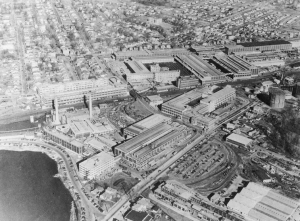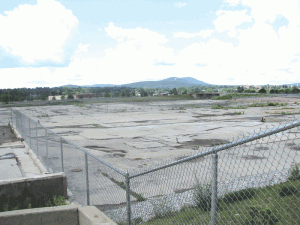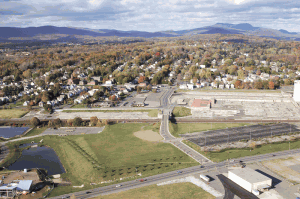
Transforming the Landscape
Pittsfield Strives to Generate Interest in Business Park at GE Site

Above, the GE Pittsfield Works in 1946. At top, an aerial shot of the portion of that same property that has become the William Stanley Business Park.
Stanley, a long-time engineer with Westinghouse, created his prototype in 1886, in Great Barrington, but his concept, which made it possible to spread electric service over a wide area, would most dramatically change the landscape — and in many different ways — in nearby Pittsfield. It was there that he started the Stanley Electric Manufacturing Co., the venture eventually purchased by General Electric and later renamed the GE Pittsfield Works, a sprawling large-transformer-manufacturing complex that, at its height in the 1960s, employed more than 13,000 people.
Today, Thurston, executive director of the Pittsfield Economic Development Authority (PEDA), is hoping that innovation can again transform this property near Silver Lake more than a quarter-century after GE announced that it was closing the massive plant. The 52-acre business park, created on roughly a dozen various-sized parcels, transferred to the city by GE in recent years, officially opened in early June with a ribbon-cutting ceremony at the Mountain One Financial Center in a corner of the property off East Street.
The facility, a 6,735-square-foot, LEED-certified structure dominated by glass, is catching the attention of the city and the region, said Thurston, who is confident that it will also capture the imagination of the business and development communities, and eventually help repopulate the mostly barren acreage with a broad mix of businesses.
“It showed the naysayers, who didn’t believe anything would ever happen here, what can be done,” he explained, adding that the quick timeline for the project — it was announced in April 2011, ground was broken that August, and construction was completed on March 30 — demonstrates how the city is committed to making things happen on the property.
Moving forward, one possible catalyst for redevelopment could be a planned 20,000-square-foot life-sciences building, said Thurston, adding that the venture could be funded through a $6.5 million earmark granted to Pittsfield as part of the Commonwealth’s Life Sciences Bond Bill.
Intended as a stage-two facility for companies looking for room to get to the next stage, the 20,000-square-foot center would be a facility that could house and foster the kind of innovation that gave the park its name.
Beyond that initiative, though, the park could become home to anything from retail to light industrial; from green-energy ventures (there’s already a 1.8-magawatt solar power array on the property) to municipal facilities.
“We’re optimistic,” said Thurston. “Typically, in the Northeast, 70% of your economic development comes from within, from expansion of companies in the market already. We’re focusing quite a bit on making sure that our existing businesses have opportunities to grow, while we’re also looking at other options such as government facilities.”
There are a number of challenges involved with redeveloping the former GE complex, said Thurston, listing everything from the stigma attached to brownfield sites, even though this one has been cleaned, to competition in the form of perhaps 1 million square feet of former mill space in Berkshire County vying for the attention of startups and established businesses alike. But he is optimistic that the park can soon become a center for both innovation and jobs, as it was decades ago.
“We believe that this is a model for cooperative remediation and redevelopment efforts across the country,” he told BusnessWest while looking over a large aerial photograph of the GE complex taken decades ago. “There is enormous potential here.”
For this issue and its focus on commercial real estate, BusinessWest ventured to Pittsfield to learn how officials there hope to transform the landscape in this section of the city and, in some ways, have history repeat itself.
Current Events
Thurston said it’s difficult to quantify or even qualify the impact GE’s operation had — and still has — on the city.

This view from the northeast shows some of the vast open space now available for redevelopment with the transfer of the former GE property to the city of Pittsfield.
And part of that reinvention is the redevelopment of the property on which Stanley Electric and then GE operated for close to a century, a project that has been ongoing for more than 13 years now and is defined by both challenges and opportunities.
Fast-forwarding through the years since a definitive economic-development agreement between GE, the city, the Environmental Protection Agency, and other parties was inked, Thurston said the 52 acres now under PEDA’s control have been remediated and transferred to the city for redevelopment. The pace of progress has often been frustratingly slow — the last parcels were not transferred until earlier this year — but significant momentum has been generated in recent months.
Standing outside the front door of PEDA’s office on Kellogg Street, which has a commanding 360-degree view of the site, Thurston hit the highlights. Pointing to his far right, toward Silver Lake, he referenced the solar installation completed by Western Mass. Electric Co. in 2010, as well as Mountain One’s project.
Turning to his far left, he pointed out a large 16-acre parcel on which several GE buildings once stood. It is, to the best of Thurston’s knowledge, the largest open, developable (“unimpeded” was the word he chose) tract in Pittsfield, and land that could be subdivided any number of ways to suit the needs of developers.
And, sweeping his hand to the right, he pointed out Woodlawn Avenue and the now-closed bridge (built in 1906) over the railroad tracks that run through the middle of the complex. The street, formerly a private way that bisected GE’s plant, will be repaired and made a public road, and a new bridge will be constructed by the state, said Thurston.
“This will hopefully be a real catalyst for our rebuild,” he said, noting that the site, hemmed in by residential neighborhoods and narrow, winding side streets, will need a secondary form of access in the form of an open Woodlawn Avenue to reach its full potential. “Finishing up these key infrastructure pieces is very crucial for us and our ability to put a large manufacturing facility or retail center that employs a large number of people on one of these sites.”
As he talked about that process, Thurston said the plan has several basic components, all designed to increase awareness of the site and its many amenities, and then bringing prospective tenants to PEDA’s door.
At present, the city is conducting some target marketing, while also working to connect with a host of public and private partners on the project, he continued, noting that this constituency includes a number of players.

Cory Thurston, seen in front of a map of the new business park, says the site has amenities that could attract ventures from across several sectors of the economy.
Meanwhile, another potential partner, and major asset, as Thurston described it, is CSX Corp., which has a rail line that runs through the middle of the site and, with Woodlawn Avenue, creates four sectors of redevelopment.
“We’re working with their economic-development team to identify rail-friendly tenants that might be interested in an opportunity in downtown Pittsfield,” he explained. “They’re in a large growth mode, and rail service could be an important factor in drawing people to this site.”
Watts Next?
PEDA and these various partners have what Thurston considers a very salable product, one with amenities attractive to businesses in a variety of sectors.
At the top of this list is developable land that is in many cases ‘shovel-ready,’ a technical term used to describe land that is clean, fully permitted, and, as the phrase suggests, ready for a shovel.
Other parcels don’t quite fit that description, said Thurston, listing that aforementioned 16-acre parcel, for example, which has elevation changes and old foundations as the primary but still minor challenges to be overcome.
Another amenity, he told BusinessWest, is location, which is driven home in promotional aerial photographs of the site that prominently feature Crystal Lake and the nearby Berkshire mountains.
Beyond scenery, though, Pittsfield is located roughly halfway between Albany and Boston, said Thurston, and thus could be an attractive option for emerging technology and life-sciences companies operating or doing business in both markets. There is also the Berkshires’ still-affordable high quality of life, he went on, adding that this mix of selling points should turn some heads.
However, there are some challenges as well, including an economy still in recovery mode, that aforementioned stigma about brownfield sites, especially one with such a high profile, and a huge glut of former mill space in Pittsfield and surrounding communities that offers an attractive alternative to business owners, and one that usually carries a lower price tag than new construction.
“We’re confronting the same challenges being faced from a manufacturing and industrial perspective across the Northeast,” he explained. “New construction is difficult, and we have a lot of wonderful facilities in Pittsfield and across Berkshire County, like some of the old paper mills that have been repurposed, where businesses can grow and expand; there’s a lot of competitive real estate that still stands.”
But overall, Thurston believes the business park is the proverbial right place at the right time, and he thinks the planned life-sciences building is a potential-laden project that could drive that point home, while also creating some potential future tenants.
As currently conceived, the center would go beyond a typical incubator, providing next-stage companies with the shared lab space, broadband capacity, and other amenities needed to make that jump to where they’re ready to begin production and take on employees.
“This would be a nice, low-cost, quality-of-life facility that they could move their venture to and continue their growth and development,” he said, adding that the next phase in the project is convincing the state to release the earmark, a process that is already underway. “We want to create something new and exciting in Pittsfield.”
Overall, PEDA will be patient with the broad redevelopment process, said Thurston, adding that, in every way possible, it will “leave its options open.”
That sentiment applies to everything from potential reuses — the site has been mentioned as home to everything from retail complexes to municipal facilities, including a new courthouse and police station — to individual parcels.
Indeed, while it is likely that the 16-acre parcel mentioned earlier will be subdivided, PEDA will not do that until options for one larger user have been explored and exhausted.
Getting Amped Up
While it’s extremely unlikely that the former GE site will again be home to 13,000 jobs, said Thurston, the business park created there has vast potential to again play a lead role in shaping the economy of Pittsfield and the surrounding area.
What that shape will be is anyone’s guess, he noted, adding that it will take years to fill in the canvas.
But the process is well underway, momentum is building, and there are clear signs that this facility can live up to the name it’s been given.
George O’Brien can be reached at [email protected]






